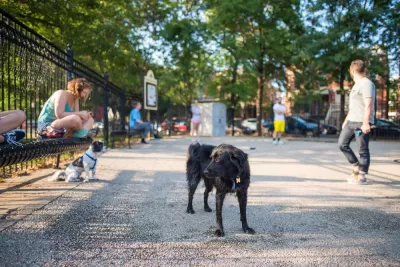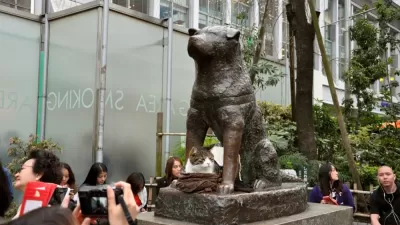The number of dog parks in the United States has almost doubled since 2007. Some worry these spaces are not welcoming or could signal gentrification.

A trend of toward making public spaces specialized for dogs strikes some as a way to exclude, "'Much like the appearance of yoga studios and trendy restaurants, dog parks are highly visible indicators of change in a city,' said Chuck Wolfe, a Seattle-based lawyer and the founder of Seeing Better Cities Group," Mary Hui writes in The Washington Post.
Hui reports on a space that became a Shaw Dog Park near Washington, D.C.'s Logan Circle. "Before that area was a dog park, it was a canchita — Spanish for a small soccer field — where a largely Latino community would play nightly fast-paced games of four-on-four pickup soccer," Hui writes. One day with no notice or explanation, that field was razed. Some see this as an example of how less politically visible or vocal groups can see their spaces taken from them.
Still dog parks have proven popular and they’re unlikely to lose that popularity any time soon. "Between 2007 and 2016, the number of dog parks across the United States grew by close to 90 percent, and dog parks are the fastest-growing type of park in American cities," Hui reports.
FULL STORY: Pups and public space: What D.C.’s dog parks say about the changing city

Alabama: Trump Terminates Settlements for Black Communities Harmed By Raw Sewage
Trump deemed the landmark civil rights agreement “illegal DEI and environmental justice policy.”

Planetizen Federal Action Tracker
A weekly monitor of how Trump’s orders and actions are impacting planners and planning in America.

Why Should We Subsidize Public Transportation?
Many public transit agencies face financial stress due to rising costs, declining fare revenue, and declining subsidies. Transit advocates must provide a strong business case for increasing public transit funding.

Understanding Road Diets
An explainer from Momentum highlights the advantages of reducing vehicle lanes in favor of more bike, transit, and pedestrian infrastructure.

New California Law Regulates Warehouse Pollution
A new law tightens building and emissions regulations for large distribution warehouses to mitigate air pollution and traffic in surrounding communities.

Phoenix Announces Opening Date for Light Rail Extension
The South Central extension will connect South Phoenix to downtown and other major hubs starting on June 7.
Urban Design for Planners 1: Software Tools
This six-course series explores essential urban design concepts using open source software and equips planners with the tools they need to participate fully in the urban design process.
Planning for Universal Design
Learn the tools for implementing Universal Design in planning regulations.
Caltrans
Smith Gee Studio
Institute for Housing and Urban Development Studies (IHS)
City of Grandview
Harvard GSD Executive Education
Toledo-Lucas County Plan Commissions
Salt Lake City
NYU Wagner Graduate School of Public Service




























